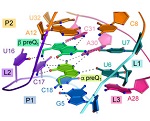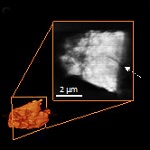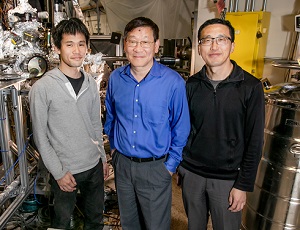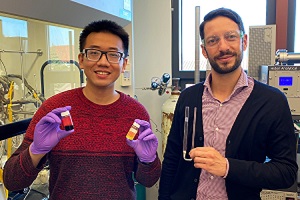
Science Highlights

Structure of a Small Riboswitch that Binds Two Metabolite Ligands in One Pocket – Contact: Joseph Wedekind, University of Rochester
RNA biologists have discovered that RNA, the chemical cousin of DNA, can bind two metabolites (small molecules) at the same time in a single binding pocket, causing those molecules to interact. This discovery, published in Nature Communications, could lead to new antibacterial drugs while helping to fill a gap in the controversial “RNA world” theory, which suggests that RNA molecules enabled life to evolve on Earth 3.5 billion years ago. Read more...

Thermodynamics-driven Interfacial Engineering of Alloy-type Anode Materials – Contacts: Qizhang Yan and Jian Luo, University of California San Diego
Increasing the power density of reusable batteries will allow electric vehicles to travel farther and cell phones and portable electronics to be used longer on a single charge. Scientists are interested in using higher power density lithium alloy materials as the battery anode instead of the commonly used graphite. Although these materials have higher power density, their capacity degrades quickly after a few recharging cycles. This is due to fractures caused by large increases in material volume when charged. A team of scientists has discovered a way to suppress fracturing and improve charge cycling stability in lithium alloy anodes by enriching the material with bismuth. Read more...
More SSRL-Related Science
Researchers Reveal the Fourth Signature of the Superconducting Transition in Cuprates
Excerpt from SLAC news article by Glennda Chui

When an exciting and unconventional new class of superconducting materials was discovered 35 years ago, researchers cheered.
Like other superconductors, these materials, known as copper oxides or cuprates, conducted electricity with no resistance or loss when chilled below a certain point – but at much higher temperatures than scientists had thought possible. This raised hopes of getting them to work at close to room temperature for perfectly efficient power lines and other uses.
Research quickly confirmed that they showed two more classic traits of the transition to a superconducting state: As superconductivity developed, the material expelled magnetic fields, so that a magnet placed on a chunk of the material would levitate above the surface. And its heat capacity – the amount of heat needed to raise their temperature by a given amount – showed a distinctive anomaly at the transition.
But despite decades of effort with a variety of experimental tools, the fourth signature, which can be seen only on a microscopic scale, remained elusive: the way electrons pair up and condense into a sort of electron soup as the material transitions from its normal state to a superconducting state.
Now a research team from SIMES and SSRL has finally revealed that fourth signature with precise, high-resolution measurements made with angle-resolved photoemission spectroscopy, or ARPES, which uses light to eject electrons from the material. Measuring the energy and momentum of those ejected electrons reveals how the electrons inside the material behave. Read more...
Analysis of the Rock Record Rules Out Atmospheric Oxygen before the Great Oxygenation Event
Excerpt from SLAC news article based on a press release from Dartmouth College
Chemical signatures that have been considered evidence for a “whiff of oxygen” in Earth’s atmosphere before the Great Oxygenation Event 2.3 billion years ago were probably introduced at a much later time, according to research published in Science Advances.
The result rewinds previous research findings and has the potential to rewrite what is known of the planet’s past, including when oxygen-producing bacteria first appeared on Earth.
The study focused on Australia's Mount McRae Shale, samples from which had been interpreted to suggest atmospheric oxygen existed earlier in Earth's history. The research team found that a series of changes after the shale first formed on the ocean floor were likely responsible for chemical evidence of oxygen.
In particular, a new set of tools, including x-ray fluorescence spectroscopy experiments using SSRL BL10-2 and nanoscale mass spectroscopy performed at the California Institute of Technology, revealed the presence of cracks in the rock where signs of atmospheric oxygen crept in long after the rock itself had formed. Read more...
Stanford Engineers Create a Catalyst that can Turn Carbon Dioxide into Gasoline 1,000 Times More Efficiently
Excerpt from Stanford news article by Andrew Myers

Engineers working to reverse the proliferation of greenhouse gases know that in addition to reducing carbon dioxide emissions we will also need to remove carbon dioxide from power plant fumes or from the skies. But, what do we do with all that captured carbon? Matteo Cargnello, a chemical engineer at Stanford University, is working to turn it into other useful chemicals, such as propane, butane or other hydrocarbon fuels that are made up of long chains of carbon and hydrogen.
A new catalyst, invented by Cargnello and colleagues, moves toward this goal by increasing the production of long-chain hydrocarbons in chemical reactions. It produced 1,000 times more butane – the longest hydrocarbon it could produce under its maximum pressure – than the standard catalyst given the same amounts of carbon dioxide, hydrogen, catalyst, pressure, heat and time. Read more...
Awards
SSRL User Matteo Cargnello Receives ACS Award
Congratulations to Prof. Matteo Cargnello, Stanford University, recipient of the 2022 ACS Early Career Award in Catalysis. This award recognizes and encourages accomplishments and innovation of unusual merit by an individual in early stages of their career, emphasizing independence and creativity. The Catalysis Science and Technology Division (CATL) of the American Chemical Society (ACS) proudly announced this and other winners of the 2022 Division Awards. These awards recognize individuals who have made exceptionally impactful contributions to the design, synthesis and/or chemical or mechanistic characterization of catalysts, which significantly advance the science and practice of catalysis. Read more...
Events
SSRL/LCLS Users' Meeting, SLAC, September 26–30, 2022 - Save the Date
We are beginning to plan for the next joint SSRL/LCLS Users' Meeting to be held September 26–30, 2022, and we welcome your input! Currently, we intend to have a hybrid meeting but will maintain the option to be fully virtual depending on the status of the pandemic. Please send us your suggestions for full- or half-day workshop topics before March 7. Workshop proposal form
Stanford Electron Microscopy-X (EM-X) Virtual Symposium on Monday, March 7, 2022, 8:00–9:30 AM (Pacific Time)
This symposium features Helen Saibil, Bernal Professor at Birkbeck College, University of London, with a talk on, "Macromolecular Machines for Disassembling Protein Aggregates and Punching Holes in Membranes," and Joachim Mayer, Professor at RWTH Aachen University, speaking about, "Correlative Characterization of Renewable Energy Materials". Webinar registration
2022 PULSE/CFEL Ultrafast X-ray Summer School, SLAC, June 20–23, 2022
The school will feature lectures from experts in ultrafast x-ray science. In addition, activities are being planned to further engage students including laboratory sessions aimed at teaching students how to analyze datasets recorded at XFEL facilities. Registration Deadlines: June 1, 2022 (Full Participation); June 18, 2022 (Lectures Only). UXSS2022 website
ULITIMA 2022 - Ultrafast Imaging and Tracking Instrumentation, Methods and Applications Conference, SLAC, October 3–6, 2022
Abstract submission is now open for the ULITIMA 2022 - Ultrafast Imaging and Tracking Instrumentation, Methods and Applications Conference, October 3–6, 2022. ULITIMA 2022 website
Announcements
LCLS/SSRL User Survey due March 11, 2022
The LCLS and SSRL User Executive Committees (UECs) are interested in collecting a comprehensive set of information about climate, inclusion, work environment, accessibility to the facilities, experiment support, and demographics of the User Community. Users are encouraged to provide feedback by March 11, 2022, by completing the survey at: https://bit.ly/2021-UEC-Survey To thank you for your participation, at the end of the Survey you can enter our draw to win one of ten $50 Amazon Gift cards.
Postdoctoral Opportunities at SSRL
SSRL scientists are looking for post-doctoral candidates for the positions in the areas listed below - find out more about the opportunities at Careers at SLAC.
- Application of Advanced X-ray Spectroscopy Methods to Metalloenzymes
- X-ray Spectroscopy Applications to Biological and Environmental Sciences
- Combining Computational Approaches with XAS for Biological and Environmental Sciences
- Study of Quantum Materials through Resonant X-ray Scattering
User Research Administration
Beam Time Request Deadline
- March 1, 2022 for May–July scheduling on X-ray/VUV beamlines
Proposal Deadlines
- Macromolecular Crystallography - April 1, 2022
- Xray/VUV - May 1, 2022
- COVID-19 related proposals for beam time at SSRL and microscope time at our CryoEM facility can be submitted at any time and will be reviewed expeditiously.
- CryoEM biology-related proposals for the S2C2 program are due on the first day of each month and are being reviewed on a monthly basis.
Submit beam time requests and proposals through the User Portal.
The Stanford Synchrotron Radiation Lightsource (SSRL) is a third-generation light source producing extremely bright x-rays for basic and applied research. SSRL attracts and supports scientists from around the world who use its state-of-the-art capabilities to make discoveries that benefit society. SSRL, a U.S. DOE Office of Science national user facility, is a Directorate of SLAC National Accelerator Laboratory, operated by Stanford University for the U.S. Department of Energy Office of Science. The SSRL Structural Molecular Biology Program is supported by the DOE Office of Biological and Environmental Research, and by the National Institutes of Health, National Institute of General Medical Sciences. For more information about SSRL science, operations and schedules, visit http://www-ssrl.slac.stanford.edu.
To unsubscribe from SSRL Headlines, just send an e-mail to listserv@slac.stanford.edu with "signoff ssrl-headlines" in the body.
To subscribe, send an e-mail to with "subscribe ssrl-headlines" in the body.
Questions? Comments? Contact Lisa Dunn




